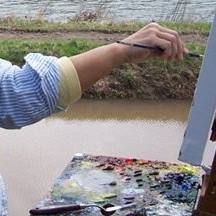
Oil on panel
15 1/16 x 26 3/8 inches
This gorgeous painting, by Daubigny has all the qualities of an alla prima one shot painting. I don’t know for sure, but it seems to me, that it was not re-worked very much in the studio. I think the drama was created effortlessly in the field. There may have been some refinement of the foreground trees but for the most part the painting has a very fresh gestural spontaneity that is so wonderful in plein air paintings.
Purist will argue that a plein-air painting must be started and finished outside. I go back and forth on this notion. I feel it depends more on what the painting needs. If you have said everything you wanted to say about that landscape in three hours then a one shot “alla prima” painting done in one sitting is fine and it is fabulous when it works out that way. More often there is a need for “tweaking” and a re-evaluation in the studio. I do not think it is a sin to make necessary adjustments to make the painting read better. To convey the intended message or theme of the painting is the important thing not how long it took or exactly how and where did you finish the painting.
Another approach is the “pochade”, which is the plein-air study or smaller painting sketch used as an aid to the development of the larger studio painting. Pioneers of plein-air painting in the 18th and 19th c. such as Valenciennes, Thomas Jones, Corot and Constable made small outdoor sketches for their own personal use and were never meant to be exhibited. these outdoor paintings were “tools”; means to an end and not the end all.
There is a real danger, however, that if you continue to work on a painting in the studio that you might lose the freshness and initial feeling of the sketch. The sense of immediacy, gesture, feeling for light and air, using quick brushstrokes contribute to the “look” of a plein-air painting.
The definition of “en plein air” means literally in the open air. The physical act of being in the field, observing nature directly and responding emotionally is very exhilarating. It is precisely this “emotional response” to nature that gives plein-air painting its’ special quality. The commitment to keep a particular kind of light and color corresponding to a particular time of day gives the painting a signature moment in time. Monet’s haystacks and cathedral paintings are a perfect example of the extreme in painting at a particular time of day.
Those only concerned with representation of fact will take the painting to a certain level. Those interested in not only recording the retinal image but transcribing the emotional impact the landscape has provided will take the painting to another personal level as in Vincent Van Gogh’s work. We feel an emotional response to the painting not simply because of the faithful recordation of fact but because somehow the artist found a way to show how this place affected him.
